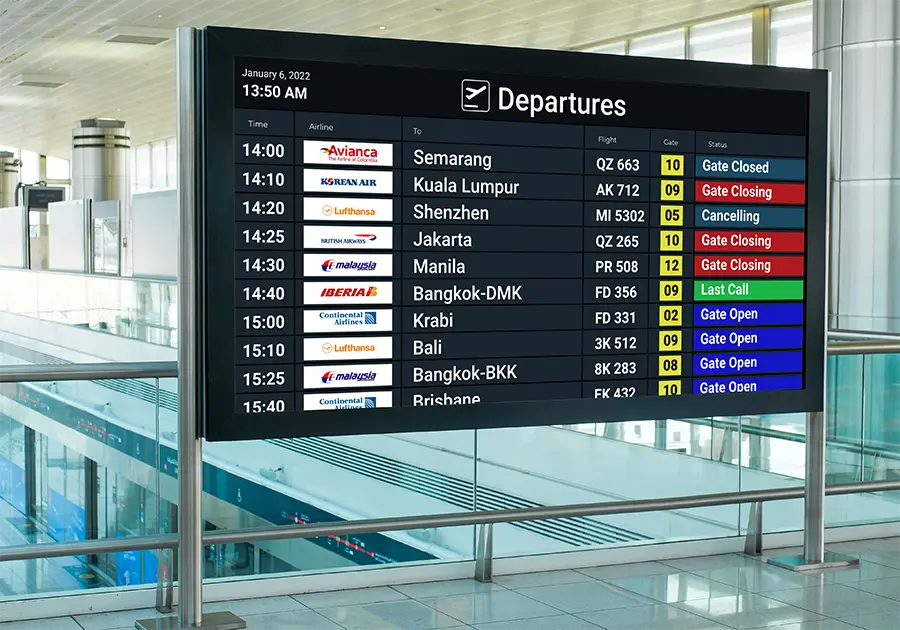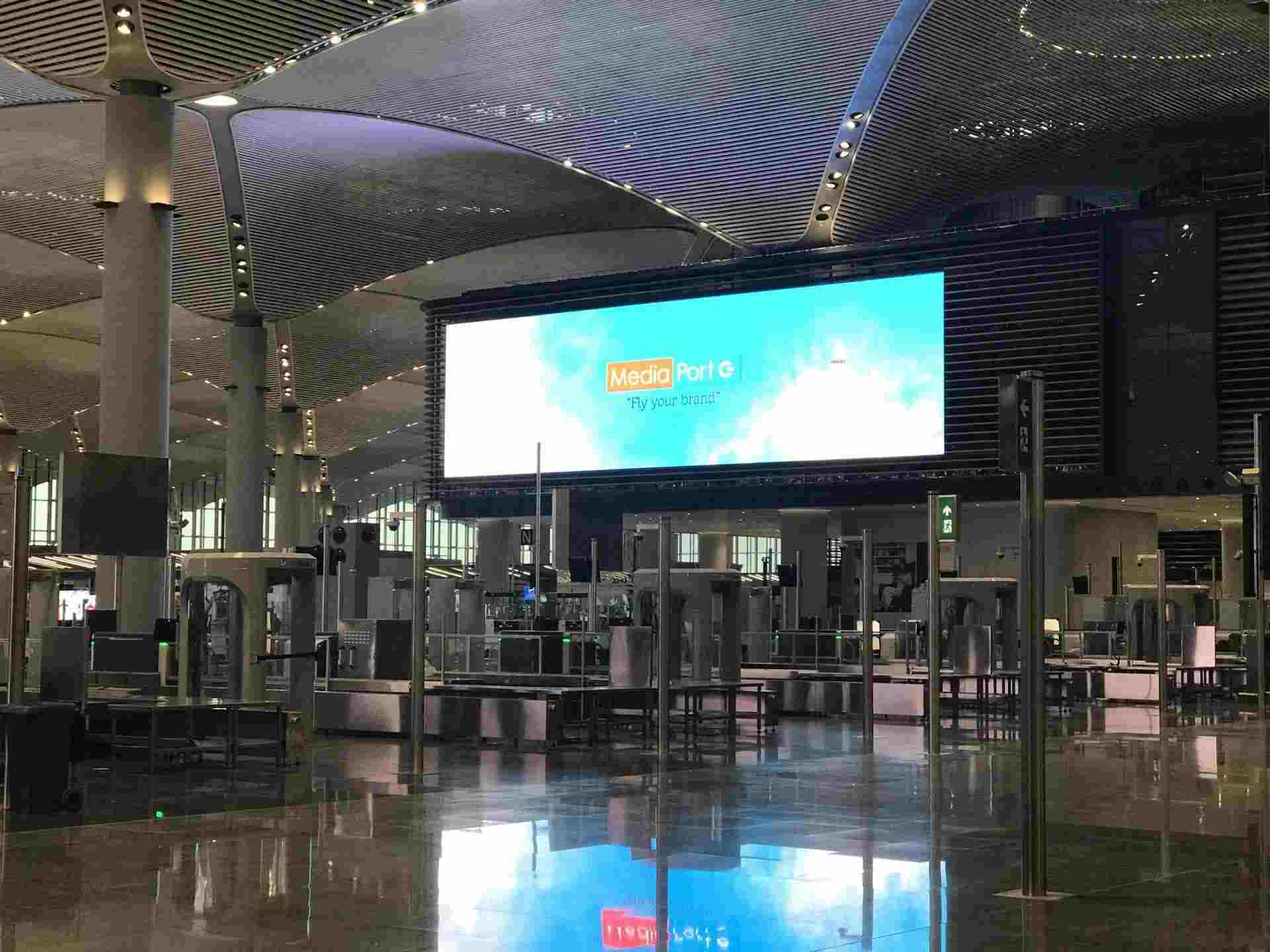Digital Signage in Airports That Speeds Up Wayfinding and Reduces Staff Load
Digital Signage in Airports That Speeds Up Wayfinding and Reduces Staff Load
Airports serve as major transportation hubs, handling millions of travelers each day. With large terminals, numerous gates, multiple levels, and a wide array of services, airports can often feel like complex mazes for passengers. One of the most significant challenges faced by travelers is finding their way around the airport—whether it’s locating a specific gate, understanding flight information, or navigating between terminals.
To address this challenge, airport digital signage is increasingly being used to streamline wayfinding and enhance the passenger experience. These digital signage solutions provide travelers with up-to-date, easy-to-understand information and reduce the pressure on airport staff who would otherwise need to assist with routine navigation questions. By adopting airport digital signage systems, airports can improve both the passenger experience and overall operational efficiency.

Why Wayfinding is Crucial in Airports
Airports are vast and often confusing environments, particularly for passengers who are unfamiliar with the layout. Miscommunication and confusion can result in missed flights, added stress, and frustrated travelers. This is where effective digital signage in airports plays a pivotal role.
Wayfinding solutions guide passengers seamlessly through their journey, helping them find the fastest routes to their destinations, whether it’s checking in, heading to security, or locating their departure gate. As airports continue to expand and evolve, airport digital signage systems are becoming more essential than ever in providing real-time, accessible information to passengers.
How Digital Signage Simplifies Wayfinding
Airport digital signage solutions offer a wide range of benefits, particularly when it comes to helping passengers navigate the airport. Here are several key advantages of using digital signage for wayfinding:
1. Real-Time Information Updates
One of the primary advantages of airport digital signage systems is the ability to provide real-time information. Flight updates, gate changes, and security wait times are all automatically updated, ensuring that passengers always have the most current information at their fingertips.
With digital signage airport systems, travelers no longer need to rely on static signs or wait in long lines to ask for directions or updates. These systems deliver dynamic content that adapts to changing circumstances, helping passengers stay on track with minimal effort.
2. Interactive Maps and Directories
Digital signage solutions can also include interactive kiosks or digital directories that help travelers find their way. By using touchscreen technology, passengers can search for their desired location, whether it’s a gate, baggage claim area, restaurant, or restroom. The system will then display step-by-step directions to guide them there.
These interactive maps make it easier for passengers to navigate large and complex airports, reducing the need for assistance from airport staff. In turn, this improves overall efficiency and minimizes the chances of passengers becoming frustrated due to confusion.
3. Multilingual Capabilities
Airports serve travelers from all over the world, which means language barriers can be a significant challenge. Airport digital signage solutions can display information in multiple languages, ensuring that international passengers can easily find their way without needing translation or assistance from staff.
Navori’s digital signage airport systems are capable of delivering multilingual content, which is crucial for providing a seamless experience for all travelers, regardless of their language.
4. Clear and Easy-to-Read Displays
Unlike traditional signage, which can become outdated or difficult to read, digital signage in airports provides clear, bright, and easy-to-read information. Whether it’s an electronic gate sign, a digital flight display board, or directional arrows, digital signage provides passengers with important information in a visually appealing and easy-to-understand format.
Dynamic, high-quality displays ensure that travelers don’t miss important details. Whether it’s a last-minute gate change or a flight delay, airport digital signage solutions provide instant clarity to passengers.
5. Customizable Content for Different Passenger Needs
Digital signage systems in airports can also be tailored to meet the specific needs of different passengers. For example, information can be displayed in larger fonts for passengers with visual impairments or with simplified graphics for children. This customization ensures that everyone, regardless of their physical abilities or age, can benefit from the signage system.
Additionally, specific areas of the airport—such as duty-free shops, food courts, or lounges—can have customized digital signage, making it easier for passengers to find exactly what they’re looking for.

How Digital Signage Reduces Staff Load
In addition to benefiting passengers, airport digital signage systems offer significant operational advantages. They streamline communication and wayfinding. As a result, airports can reduce staff burdens and improve efficiency.
1. Fewer Inquiries for Staff Assistance
When digital signage is in place, travelers are less likely to ask staff for basic information, like directions to a gate or flight updates. This means airport employees can focus on more complex tasks, such as managing disruptions or assisting passengers with special needs. Staff no longer have to answer repetitive questions about wayfinding.
With digital signage airport systems, passengers have the information they need independently. This allows staff to allocate resources more effectively.
2. Simplified Content Management
Traditional signage requires manual updates and can become outdated quickly, especially when airport layouts or flight schedules change. Airport digital signage solutions are easy to manage and can be updated remotely in real time.
This eliminates the need for physical updates. Airport operators can respond to changes quickly. If there’s a last-minute gate change or emergency, the signage can be updated instantly. This ensures passengers always have the most accurate information.
3. Instant Communication During Emergencies
In an emergency or unexpected disruption, such as a security incident or weather-related delay, digital signage airport systems can quickly display important safety instructions or changes to procedures. This keeps passengers informed and safe without needing staff intervention.
The ability to share emergency information quickly and effectively makes digital signage an invaluable tool for modern airport operations.
4. Improved Resource Allocation
By reducing the number of basic inquiries, digital signage in airports helps better allocate staff. Instead of stationing employees to answer simple questions, airports can free them up for higher-priority tasks. This improves overall efficiency.
Conclusion: Transforming Airport Operations with Digital Signage
As airports grow and handle more passengers each year, digital signage in airports is proving to be a powerful tool. It improves both wayfinding and staff efficiency. By offering real-time, interactive, and customizable information, airport digital signage systems help passengers navigate large, complex spaces with ease. At the same time, they reduce the load on airport staff.
Navori’s airport digital signage solutions are designed to enhance the passenger experience. They make it easier for travelers to find their way, stay informed, and move through the airport efficiently. By adopting these advanced systems, airports can improve operations. They can also reduce stress for both passengers and staff, creating a more seamless and enjoyable travel experience.
Case Study About Istanbul Airport: A Digital Signage Success Story
Istanbul Airport, one of the largest and busiest airports in the world, faces the complex challenge of managing and delivering real-time information to millions of passengers every year. To streamline operations and enhance the traveler experience, Istanbul Airport turned to Navori for its digital signage solution powered by Navori software.
Seamless Content Synchronization
Navori’s digital signage system at Istanbul Airport ensures that content is delivered consistently across all displays. Powered by Navori software, the system synchronizes multimedia content across various hardware platforms, creating a cohesive visual experience throughout the airport. This synchronization is crucial for maintaining uniformity, especially in such a large and dynamic space.
Real-Time, High-Quality Content Management
The Navori software supports high-quality, dynamic content delivery, which is essential in a high-traffic environment like Istanbul Airport. Whether it’s flight information, advertising, or emergency updates, Navori ensures that content is updated in real time and is displayed clearly across the terminal. The system also supports multi-zoned templates, making it easy to deliver customized content in different areas of the airport.
Advertising and Proof-of-Play Reporting
Istanbul Airport’s advertising network benefits from the advanced features of Navori software, which automates ad insertion and provides detailed performance metrics. This allows advertisers to track the effectiveness of their campaigns and adjust content accordingly, optimizing the airport’s advertising revenue.
Audience Measurement and Insights
One of the key features of the Navori software is its integration with AQUAJI, Navori’s computer vision solution. This integration allows Istanbul Airport to track foot traffic and gather demographic insights. These valuable metrics help both the airport and its advertisers tailor content and advertising strategies to meet the needs of specific passenger groups.
Context-Aware Content Playback
The Navori software at Istanbul Airport is context-aware, meaning it can adjust content based on external data. For example, the system can display weather updates, traffic information, or other relevant messaging based on real-time conditions. This adaptability ensures that passengers receive the most timely and useful information while navigating the airport.
You can learn more by visiting the full case study here: navori.com/customers/istanbul-airport-deploys-a-navori-ql-powered-digital-signage/

